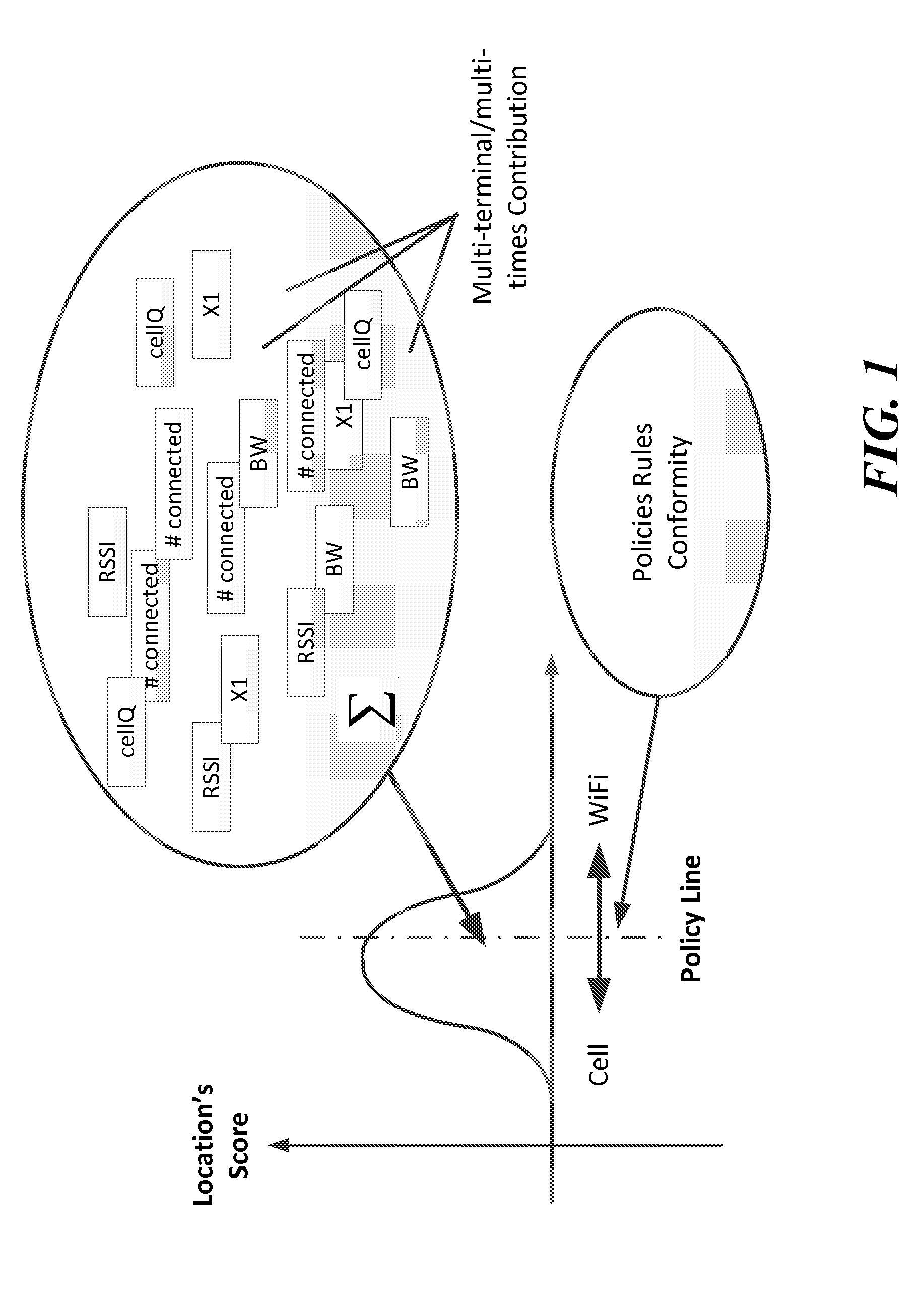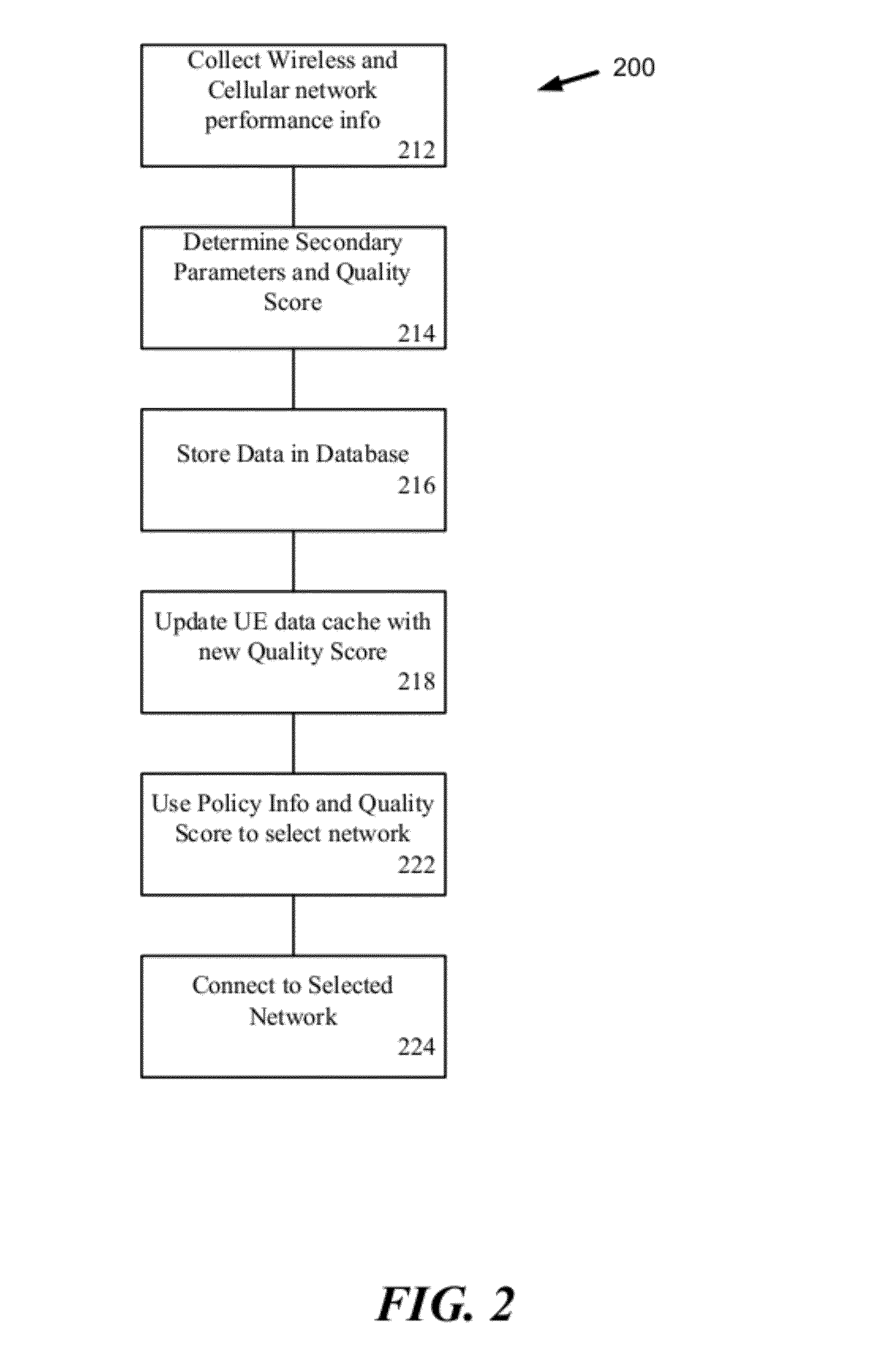[0057]The present invention is directed to methods and systems for receiving
network connection information from two or more wireless user terminals (UEs), aggregating the connection information into a database where each network can be given a network quality
score and the quality scores of one or more wireless networks can be used in conjunction with network connection policies to select the best
wireless network for the existing environmental conditions—for example, connect to the network providing the highest bandwidth or lowest error rate or
noise. The network selection decision can be changed dynamically as a function of the network policies, and
network performance and conditions (quality scores and the individual connection information elements used to determine the quality
score). By using real-time
network performance information in combination with known historical
network performance information, better network selection decisions can be made.
[0058]In prior art systems and devices, network policies typically define operational limits of the device without consideration of real-time or historical performance information. Thus, for example, a network policy can limit the ability of a device to establish a connection to networks and access points operated by the carrier or network operator. Under this policy, the device will not attempt to establish a connection with a
third party network or access point, even where it has the capability. In accordance with some embodiments of the present invention, the network policy can be modified, enhanced or expanded, such that where the performance of the carrier / operator network is poor and below a predefined threshold, the policy can be modified to enable the connection to a
third party network or access point. This aspect of the invention enables the carrier / operator to, for example, offload network traffic in the event of an outage or local
system congestion to avoid poor user experience at the expense of
purchasing bandwidth from a
third party network. The policy can be changed by the operator / carrier by adjusting the threshold up or down to suit their needs. In addition, the network policy is dynamic in the sense that when carrier / operator
network conditions improve (e.g., the outage is resolved or the congestion is abated) the
user device can be reconnected to the carrier / operator network, minimizing the additional expense to the carrier / operator as well as the
[0059]A database can be used to inform user terminals about
usable wireless networks within range, for example—WiFi access points in its neighborhood. This database can collect connection information from two or more user terminals using
crowd sourcing—user terminals within range of a
wireless access point, connect to the access point and report on the connection status and performance of the access point. Since this database leverages
crowd sourcing to identify and classify wireless access points, this approach can offer an
order of magnitude more wireless access points than the carrier / partner's owned resources. In addition, the methods and systems according to the invention can be used to predict wireless and cellular
service quality at given locations using “locations'
score”. This score can be used, in addition to other policy rules, to determine whether a wireless end user terminal should be taken off the
cellular network and connected to one of the available wireless networks thereby reducing the likelihood of QoS related problems.
[0060]In accordance with some embodiments of the invention, a connection decision can be based on historical information of an end user's activity taking in account real-
time information about the selected network at the time of the decision. In accordance with some embodiments of the invention, the wireless environment in a location or hotspot can be characterized using wireless activity history thereby facilitating high quality decision. Both WLAN and cellular connections can be evaluated. The connection decision can be made whereby the likelihood of necessary connection change is minimized.
[0062]A networks resources database can be used to enhance the decision and selection capability. A
software client in on or more end user terminals can collect and report on each available network's (including the cellular networks) performance to enable each network to classified and characterized base on real-
time data and to aggregate the real-
time data to provide a
historical record of past performance at a given location at or over a particular
time of day or period of time. Basic
data analysis techniques, as well as
data mining techniques can be used to determine a performance score for each network at a location where the reports were generated. These performance scores can be used in conjunction with predefined carrier policies to select the connection (e.g., cellular or other
wireless resources) while avoiding connection hopping as the device searches for a reliable network connection. In addition, as
network conditions at a location change (for example, new network infrastructure is installed), the carrier policies can be revised to accommodate the change to improve user experience.
 Login to View More
Login to View More  Login to View More
Login to View More 


